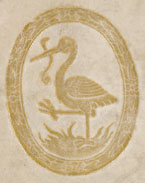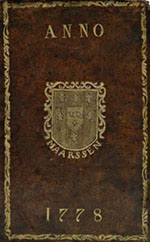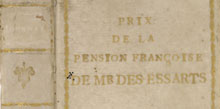Bookbindings of the Koninklijke Bibliotheek (KB), The National library of the Netherlands > A special category: Prize bindings
A prize... a prize...look mummy dearest!
A prize... a prize I really did get!
And the teacher said: you didn't forget
To really pay attention, my sweetest!
Oh! Look... tell me what you think of this feat.
Am I now also your child sweet?
The overjoyed child showed his mother the prize, a book. Received for paying attention! The poem, written around 1850, marks the end of the traditional prize binding.
Gifts for exceptional achievements
This phenomenon was originally seen in the 16th century but was not seen in the Netherlands until the beginning of the 17th century. Pupils who had performed exceptionally well at the Latin School (present-day university preparatory education) received a book that had been specially bound for the occasion. Initially, only a few schools in a limited number of cities handed out this prize, but in the 18th century prize bindings that had been handed out in Veere, Dokkum, Muiden and Wageningen were found in addition to those from Amsterdam and The Hague.
The Koninklijke Bibliotheek possesses an extensive collection of these prize bindings, where more than 50 different places have been represented.
Each year, the books, mainly texts by classic and humanist authors, were bound again specially for the occasion of the prize presentation. The local governments were responsible for the necessary funds which is why the bindings were adorned with the coat of arms of the city.
The prize presentation
During the ceremony, often even including music and a play, the prizes were presented. The chosen pupils said a word of thanks in Latin (de gratiarum actio, sometimes still present as a loose leaf in the book), often written by the principal or vice principal for a fee. A so-called oratio was given by the pupils leaving the school to go to college.
Characteristic appearance
The Dutch prize bindings had a characteristic appearance. Most of them were bound in parchment and were adorned with the coat of arms of the city on the front and back covers. At the front of the book could be found the prize assignment or ex-praemio, a completely hand written or completely or partly pre-printed piece of paper with details of the date of the presentation, the pupil's name, the class and the nature of the prize.
Education reforms
The Latin School custom of presenting such prizes was continued until around 1860, despite the many education reforms. But from about 1800 other educational institutes also started handing out prizes to their pupils. Prizes were presented by municipal schools for the poor, Nederduitsche schools, ‘tusschenscholen' (intermediate schools) and "training and teacher training schools for young daughters".
Introduction of the publisher's binding
The publisher's binding was introduced around 1830. Sometimes pupils still got hand-bound books but schools increasingly make do with an already bound copy in which the prize assignment had been glued afterwards. There were prizes for correctly reciting lessons in church (Sunday school), for diligence and good behavior, for useful needlework, for good attendance at school and "for getting 180 cards for diligence".
In the larger cities, the prize presentation was a proper ceremony, that strongly resembled the festivities at the Latin Schools. The Oeconomische Courant (Economic journal) of January 1800 reported on the presentation of honorable prizes to more than 215 pupils of the municipal school for the poor in Amsterdam, complete with "apt music" and many speeches. As a matter of fact, besides books, "two shirts and two pairs of socks" were presented as a prize.



